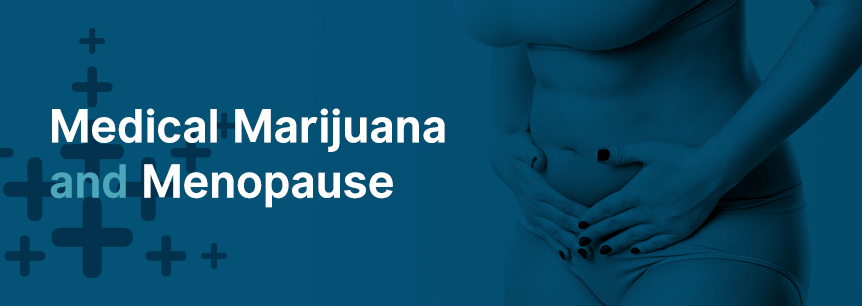
Menopause is something that nearly all women experience. A woman’s reproductive years typically begin when she is between 10 and 18 when she starts having a menstrual period. In most cases, these reproductive years last for several decades, characterized by mostly regular periods, unless the woman is pregnant. If you are experiencing “the change,” it means your body is beginning to transition away from these reproductive years to the next stage of your life.
Though this transition is entirely natural, as you go through it, you may experience some symptoms that could range from uncomfortable to unbearable. As we will see, medical marijuana can be an excellent way to experience natural relief from the symptoms associated with menopause.
Though most women are generally aware of what menopause is, it’s easy to become confused about different terms associated with menopause, including premenopause, perimenopause and postmenopause in addition to the term menopause itself. Additionally, there are two classifications for menopause — natural and induced. Let’s look at each of these terms to clarify what menopause is along with its related terms.
Premenopause is a generic term that can refer to any time in a woman’s reproductive life before menopause. Some people may use it to refer to a short amount of time before menopause, but it can also be used to refer to the entirety of a woman’s reproductive period.
When women’s bodies begin to change, primarily marked by decreased estrogen production, this time is called perimenopause. Many people refer to this transition period leading up to menopause as menopause itself, but this is technically incorrect. It is actually perimenopause that causes the symptoms that are often referred to as menopausal symptoms.
Menopause technically refers to a woman’s final menstrual period, though many people use the term to refer to the whole transition to this point. A woman can know with certainty that she has reached menopause when it has been one full calendar year since her last period or the last time she experienced any degree of spotting. Not having a period is known as amenorrhea. This year-long duration of amenorrhea signifies that a woman’s periods have permanently ceased and that she can no longer get pregnant.
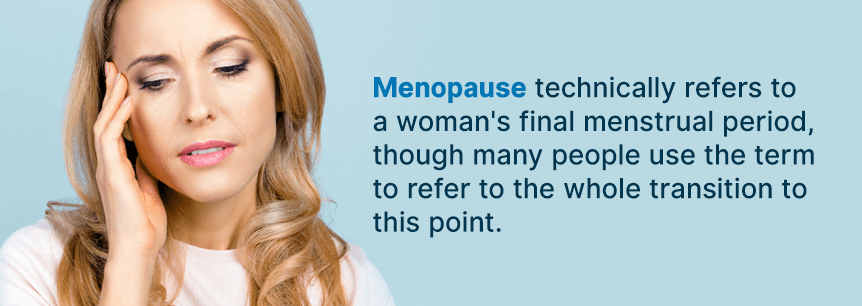
In most cases, menopause occurs naturally. However, it can be brought on by medical interventions that affect a woman’s ovaries, including surgical removal of the ovaries, damage from chemotherapy or radiation or from pharmaceuticals intended to force the onset of menopause. Women whose menopause is induced will experience the same symptoms but will not have the benefit of a more gradual transition period.
The term postmenopause is used to label the time after a woman has gone through menopause, meaning it has been one year since her last period. At this time, menopausal symptoms may go away, but a woman’s body has entered a new normal. The lower estrogen level puts postmenopausal women at a higher risk of specific health issues, including heart disease and osteoporosis.
Menopause does not affect all women the same way. However, the hormonal changes menopause brings often cause some or all of these symptoms:
Let’s look at several statistics that can help build our understanding of menopause in the world today.
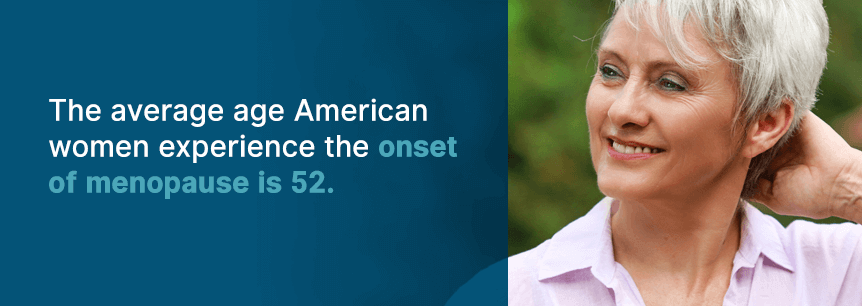
Some women may not experience symptoms that are severe enough to motivate them to find treatment. In many cases, however, women may seek relief to keep their symptoms from interfering with their daily lives. They may try one or several different treatment options to help alleviate their symptoms. Since menopause is a natural process and not a disorder, treatment options are not meant to “cure” or resolve menopause but simply to lessen the impact of menopausal symptoms. Let’s look at several common methods of treating these symptoms:
One of the most common means of treating menopause is through hormone replacement therapy (HRT). Since the symptoms associated with perimenopause stem from the drop in hormone levels your body experiences, replacing some of these hormones can lessen the severity of symptoms. Combination HRT involves taking both estrogen and progesterone. Women who have undergone a hysterectomy will only be prescribed estrogen. Hormones can be administered via a pill, patch, cream or vaginal ring among other means.
The possible side effects of HRT include:
Hormone replacement therapy could also put you at risk for more long-term problems. A large clinical trial of the popular combination estrogen-progestin pill Prempro revealed that it caused an increased risk of the following health problems:
If the symptoms you want to treat are limited to your vagina, you can use a low dose of estrogen that you administer vaginally. Because this type of hormone treatment is much more subtle, it does not involve the same level of risk for side effects or complications.
If hormone replacement therapy isn’t an option, some women are prescribed other types of pills, typically to help them with hot flashes. Most of these drugs have other uses beyond treating menopausal symptoms. For example, the drug Gabapentin, which is primarily used for nerve pain and to treat seizures, can also help with hot flashes. This medication often causes dizziness, drowsiness and lack of coordination. The blood pressure medication Clonidine is also useful for providing relief from hot flashes. It can cause side effects similar to Gabapentin along with possible dry mouth and constipation.
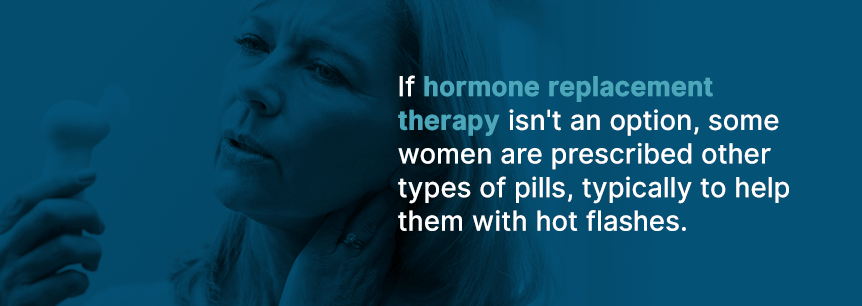
Non-hormonal prescription medications designed explicitly for menopause are rare, but one example is Conjugated Estrogens-Bazedoxifene, which treats hot flashes and is meant to help preserve bone mass. Its side effects include:
In some cases, a doctor may prescribe antidepressants for perimenopausal or menopausal women. Antidepressants may help alleviate hot flashes and can also help with mood changes a woman may experience during this time. Though antidepressants can have some positive effects, they are also known for their ability to cause a whole host of negative side effects, including:
Women who choose not to take prescription medications may find relief in certain homeopathic remedies or lifestyle changes. Generally speaking, these treatment options don’t cause the negative side effects that prescription medications do. Some natural remedies and lifestyle changes that could help a woman as she goes through perimenopause and after she reaches menopause include:
With the many negative side effects you can expect from prescription drugs, it’s no wonder some women are desperate for an alternative. The natural remedies and lifestyle changes discussed above can help, but unfortunately, there are relatively few studies to support their efficacy. There is another natural remedy that is worth considering, however — one that shows great promise for relieving symptoms related to menopause.
Because marijuana is not legal nationwide, clinical research on marijuana is limited. Therefore, there are no studies that directly look at marijuana as a method of treatment for menopause. However, there is a solid base of research to support the idea that marijuana can help with many symptoms of menopause, including hot flashes, insomnia, changes in mood, depression, anxiety, and low libido.
Why does marijuana help ease symptoms that are the result of a drop in hormones, especially estrogen? The answer is found in the relationship between estrogen and the body’s endocannabinoid system. Estrogen regulates the fatty acid amide hydrolase (FAAH) which breaks down some endocannabinoids. When estrogen levels are up, so are endocannabinoid levels. When estrogen levels drop, so do endocannabinoid levels since FAAH is allowed to break down more endocannabinoids. The idea is that it is not just estrogen helping to regulate the body but the endocannabinoid system, too.
Where does marijuana fit into this? Marijuana has cannabinoids that directly interact with your endocannabinoid system, supplementing the lower endocannabinoid levels. These endocannabinoid levels are thought to have a strong influence on a person’s mood as well as other physiological factors, so supplementing low cannabinoid levels caused by a drop in estrogen can make a significant difference.
There is still room for scientists to learn more about the endocannabinoid system and the effects of cannabis, but it is already clear that it plays an important role. Since hot flashes are a major symptom of menopause, it’s especially interesting to note that tetrahydrocannabinol (THC), a compound in cannabis, mimics many aspects of anandamide, an endocannabinoid in the body, including the fact that they have both been found to help to regulate body temperature.
Another study of interest demonstrated that cannabidiol (CBD), another compound in cannabis, had antidepressant-like effects in mice, suggesting that it could effectively combat depression in humans, as well. Yet another study demonstrated that regulating a woman’s cannabinoid levels could help boost bone density, which is extremely important for menopausal and postmenopausal women.
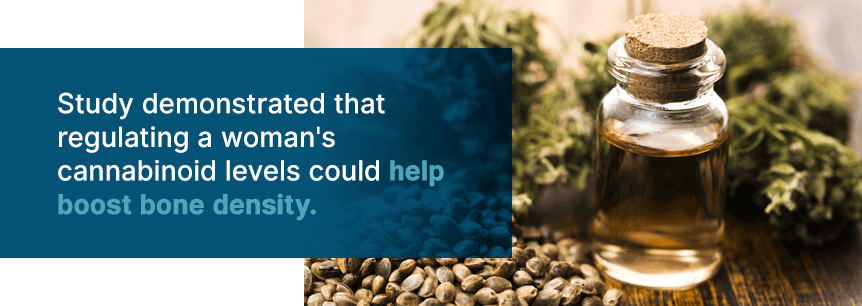
Medical cannabis can be administered in a variety of ways, including:
Different methods may work best depending on the effects you want. For example, vaporizing or smoking deliver fast-acting results while some other methods, like consuming edibles, are slower and longer-lasting.
Being a natural substance, marijuana doesn’t involve a mile-long list of side effects like many pharmaceuticals do. However, it does cause some side effects. The good news is that, with so many strains to choose from, if you don’t like the reaction you experience from one strain, you can always try another.
Here are a few side effects to be aware of that cannabis could cause:
Excessive use of marijuana can cause more serious issues, which is why it’s essential to use medical cannabis for menopause under the oversight of a licensed doctor. Even if you don’t use it excessively, smoking marijuana could potentially cause respiratory problems, simply because you’re inhaling smoke. For this reason, many people choose a different method of administering the drug.
Many strains of marijuana could help alleviate menopausal symptoms and leave you sleeping better and feeling better during the day.
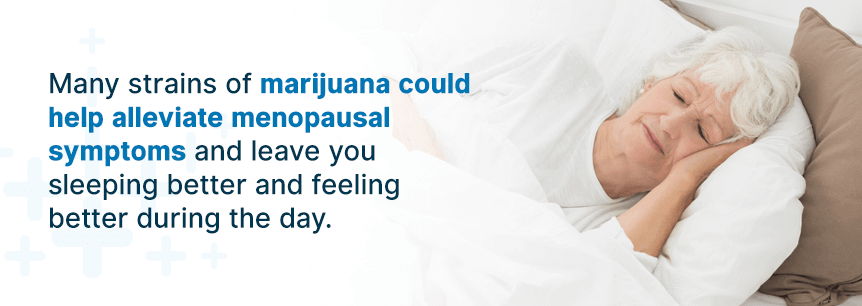
Start by asking your doctor or budtender about trying these strains:
If you are experiencing unpleasant symptoms due to perimenopause or menopause, medical marijuana could help. As we’ve seen, it’s an effective means of making up for some of the changes your body is undergoing and imparting you with feelings of relaxation and relief.
If you’re interested in talking to a doctor to develop a treatment plan, start by searching MarijuanaDoctors.com for a medical cannabis doctor or a dispensary near you. Our doctors all have the experience and appropriate licensure to provide you with expert guidance and a recommendation for cannabis for menopause.
Find A Doctor Find A Dispensary